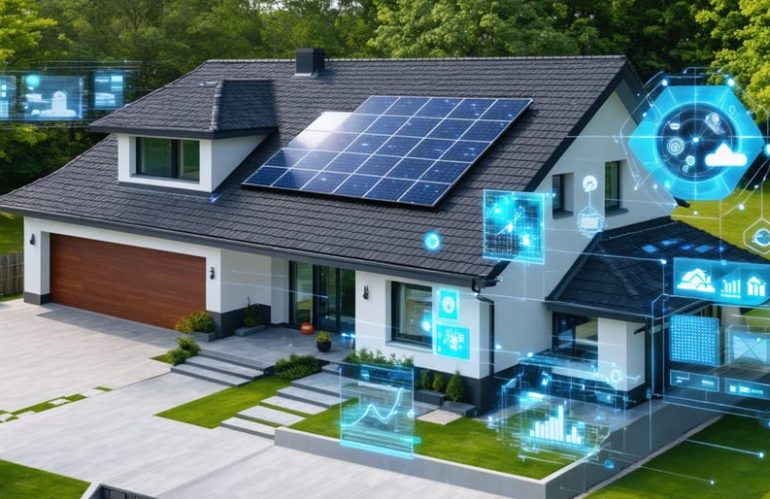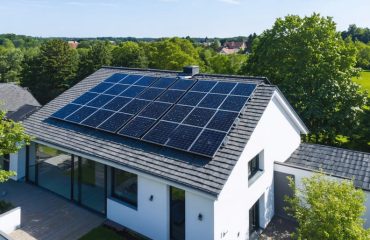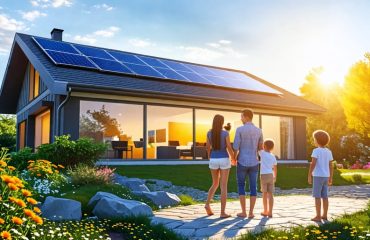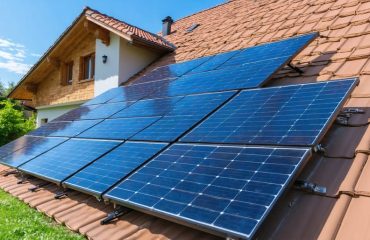Transform your home into a clean energy powerhouse with residential solar panels – a proven investment that slashes electricity bills while boosting property value. Modern solar technology has evolved far beyond basic panels, offering homeowners unprecedented control over their energy future. Today’s sophisticated systems seamlessly integrate with smart home technologies, allowing you to maximize energy efficiency through real-time monitoring and automated adjustments.
As energy costs continue climbing and climate concerns mount, residential solar installations represent more than just environmental responsibility – they’re a strategic financial decision. With federal tax incentives, improved battery storage options, and panels that are 20% more efficient than just five years ago, homeowners now enjoy shorter payback periods and greater energy independence than ever before.
Whether you’re looking to eliminate your electricity bill, reduce your carbon footprint, or protect against power outages, today’s customizable solar solutions offer the flexibility to match your specific needs and budget. From sleek black panels that complement your home’s aesthetics to advanced microinverter systems that optimize performance, residential solar has never been more accessible or attractive to homeowners.
Panel Types and Design Options
Monocrystalline vs. Polycrystalline Panels
When choosing solar panels for your home, you’ll likely encounter two main types: monocrystalline and polycrystalline panels. Each has distinct characteristics that can affect both performance and appearance.
Monocrystalline panels are made from single-crystal silicon, giving them a sleek, uniform black appearance that many homeowners prefer. They’re known for their higher efficiency rates, typically converting 15-22% of sunlight into electricity. This superior efficiency means you can generate more power in a smaller space, making them ideal for homes with limited roof area. They also perform better in low-light conditions and tend to last longer, though they come with a higher price tag.
Polycrystalline panels, distinguished by their bluish, speckled appearance, are manufactured from multiple silicon crystals. While they’re slightly less efficient (13-17%), they’ve become increasingly popular due to their more affordable price point. The manufacturing process creates less waste, making them an environmentally conscious choice. They perform well in warm weather but may lose some efficiency compared to monocrystalline panels in low-light or high-temperature conditions.
For most homeowners, the choice often comes down to available roof space and budget. If roof space is limited or you’re seeking maximum efficiency, monocrystalline panels might be worth the investment. If you have ample roof space and want to maximize your return on investment, polycrystalline panels could be the better choice.
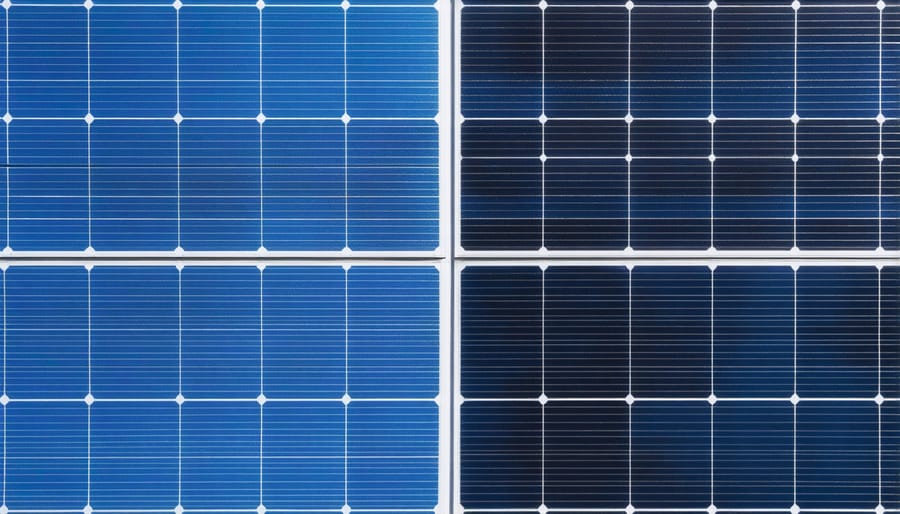
Solar Tiles and Integrated Solutions
Solar tiles and integrated solutions represent the perfect blend of aesthetics and functionality in modern solar technology. These innovative products seamlessly merge with your existing roof design, offering a sleek, unified appearance that traditional solar panels can’t match. Rather than mounting panels on top of your roof, solar tiles actually become part of your roofing system, protecting your home while generating clean energy.
Leading manufacturers now offer solar tiles in various styles and colors that mimic traditional roofing materials, including slate, terra cotta, and conventional asphalt shingles. This design flexibility allows homeowners to maintain their property’s architectural integrity while embracing renewable energy. Some premium options even feature smart features like snow-melting capabilities and enhanced durability against severe weather.
While solar tiles typically cost more than conventional panels, they often increase property value significantly due to their superior aesthetics and dual functionality. Many homeowners find that this investment pays off through enhanced curb appeal and energy savings. Installation is typically handled by certified professionals who ensure proper integration with your existing roof structure.
For those concerned about future maintenance, most solar tile systems are designed with easy access points for repairs and come with comprehensive warranties. Many systems also include monitoring capabilities, allowing you to track energy production through smartphone apps or web interfaces, making it simple to optimize your home’s energy usage.
Size and Configuration Options
Roof Space Optimization
Making the most of your available roof space is crucial for maximizing solar energy production. Start by conducting a thorough roof assessment to identify the most suitable areas for optimal panel placement. South-facing roof sections typically receive the most sunlight in North America, making them ideal for panel installation.
Consider removing or relocating obstacles like satellite dishes and vents to create larger continuous spaces for panel arrays. Most solar installers recommend leaving a minimum of two feet of clearance from roof edges and maintaining proper spacing between panels for maintenance access.
The layout of your panels should account for local weather patterns and seasonal sun angles. In snowy regions, a steeper tilt angle helps prevent snow accumulation, while areas with high winds may require additional spacing between panel rows.
To maximize efficiency, group panels in rectangular configurations rather than scattered arrangements. This not only improves aesthetic appeal but also simplifies wiring and reduces installation costs. Modern solar design software can help create virtual layouts that account for shade patterns throughout the day and seasons.
Remember to plan for future expansion by leaving appropriate space and ensuring your initial installation includes proper electrical capacity for additional panels later on.
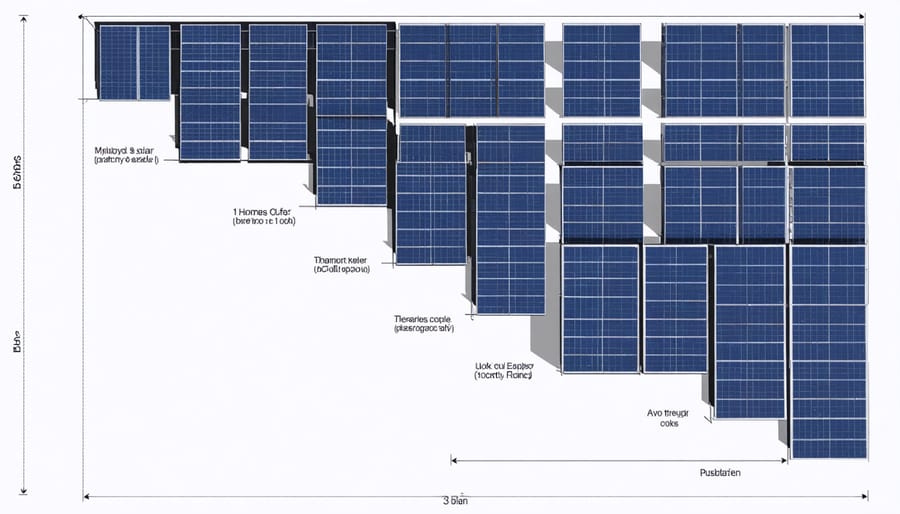
Expandability Features
One of the best features of residential solar systems is their ability to grow with your energy needs. Most modern installations are designed with future expansion in mind, allowing you to add more panels or upgrade components as your household’s energy consumption increases or as your budget allows.
When planning your initial installation, consider leaving extra roof space and ensuring your inverter can handle additional capacity. Many homeowners start with a basic system covering 60-80% of their current energy needs, then expand over time. This phased approach makes the initial investment more manageable while maintaining the flexibility to scale up.
Modern solar equipment typically includes standardized connections and compatible mounting systems, making it easier to add panels later. However, it’s important to document your original system specifications and work with installers who use industry-standard components to ensure seamless integration of new equipment.
Smart monitoring systems can help you track energy usage patterns and determine the optimal time for expansion. Some systems even allow for the integration of battery storage solutions later, providing greater energy independence and backup power capabilities.
Before planning any expansion, check your roof’s structural capacity and local regulations regarding system size limits. Many utility companies have specific requirements for expanded systems, so it’s wise to research these factors during your initial installation.
Smart Technology Integration
Monitoring Systems and Apps
Modern smart monitoring systems have revolutionized how homeowners interact with their solar installations. These user-friendly apps and platforms provide real-time insights into your system’s performance, helping you maximize your investment and ensure everything runs smoothly.
Most monitoring solutions offer intuitive mobile apps and web portals that display your solar production, energy consumption, and savings in easy-to-understand graphs and charts. You can track your system’s output throughout the day, compare performance across different time periods, and receive instant alerts if any issues arise.
Popular features include daily energy production reports, weather forecasting integration, and automatic maintenance notifications. Some advanced systems even allow you to control individual panel performance and integrate with your home automation setup. This means you can optimize energy usage by scheduling high-consumption appliances during peak solar production hours.
Many monitoring platforms also provide social sharing features, letting you compare your solar performance with neighbors and share your environmental impact on social media. These systems typically store your historical data, making it easy to track long-term savings and system efficiency.
The best part? Most modern solar installations include monitoring capabilities at no extra cost, with manufacturers offering free apps that keep you connected to your system wherever you are.
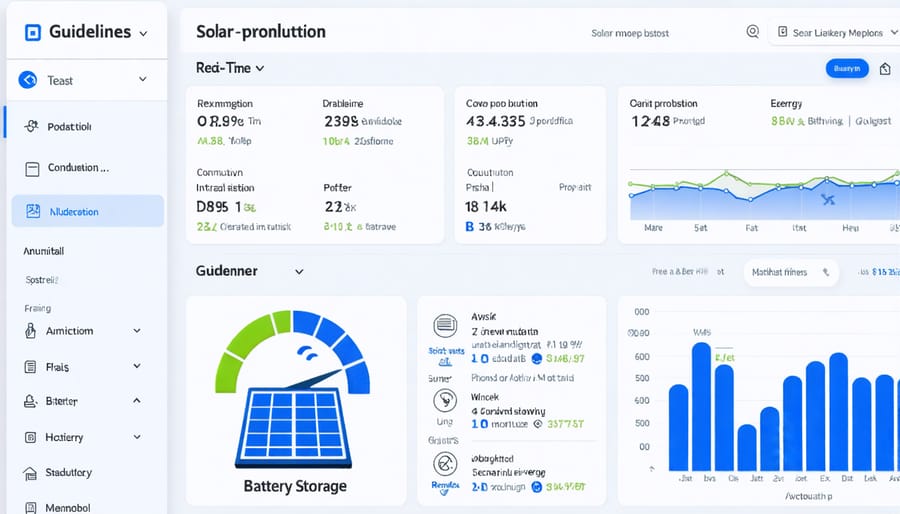
Smart Home Compatible Options
Modern solar panel systems seamlessly integrate with your existing smart home ecosystem, offering unprecedented control and monitoring capabilities. Most leading solar installations now come with smart inverters and monitoring systems that connect directly to your home’s Wi-Fi network, allowing you to track energy production and consumption in real-time through user-friendly mobile apps.
Popular smart home platforms like Amazon Alexa, Google Home, and Apple HomeKit can be configured to work with your solar system, enabling voice commands and automated routines. For example, you can ask your virtual assistant about your daily energy production or set up automation that adjusts your home’s energy usage based on solar generation patterns.
Many solar systems also integrate with smart thermostats like Nest or Ecobee, optimizing your home’s heating and cooling schedule to maximize solar power usage. Smart electrical panels and energy monitoring systems can automatically direct solar power to high-priority appliances or storage systems when needed.
For enhanced efficiency, you can pair your solar system with smart plugs and switches to automatically run energy-intensive appliances during peak solar production hours. Some systems even offer predictive features that use weather forecasts to optimize energy usage and storage, ensuring you get the most from your solar investment while maintaining comfortable living conditions.
Remember to discuss specific smart home integration options with your solar installer, as compatibility can vary between different manufacturers and system components.
Energy Storage Solutions
Battery Storage Options
Battery storage systems are becoming an essential component of residential solar installations, allowing homeowners to store excess energy for use during nighttime or cloudy days. The most popular option is lithium-ion batteries, which offer excellent performance, long life spans, and compact designs. These systems typically last 10-15 years and provide reliable backup power during grid outages.
For most homes, a battery capacity between 10-15 kWh is sufficient to power essential appliances overnight. However, larger systems up to 20 kWh or more are available for homes with higher energy demands. Some homeowners choose to install multiple batteries in parallel to increase their storage capacity over time.
Lead-acid batteries offer a more budget-friendly alternative, though they require more maintenance and have shorter lifespans. While less common in new installations, they can be suitable for homes with basic backup power needs.
Smart battery systems include features like remote monitoring, automatic power management, and integration with home automation systems. These intelligent features help optimize energy usage and can even participate in utility demand response programs, potentially earning additional savings.
When selecting a battery system, consider factors like daily energy consumption, backup power needs, and available space. Many manufacturers offer modular solutions that can be expanded as your energy needs grow, providing flexibility for future upgrades.
Backup Power Integration
Integrating backup power solutions with your solar panel system ensures your home stays powered even during grid outages. The most common approach is pairing your solar installation with a battery storage system, which stores excess energy generated during sunny days for use during nighttime or emergencies.
Modern solar batteries, such as the popular lithium-ion systems, can power essential appliances like refrigerators, lighting, and medical equipment for several hours or even days. When selecting a backup system, consider your critical power needs and typical outage duration in your area to determine the appropriate battery capacity.
Many homeowners opt for a hybrid system that maintains grid connection while providing emergency backup. This setup offers the best of both worlds: lower electricity bills during normal operation and peace of mind during outages. Smart inverters automatically switch to battery power when grid electricity fails, ensuring a seamless transition that protects your electronics.
For complete energy independence, you can design your solar system with enough panels and battery storage to go fully off-grid. While this requires a larger initial investment, it provides maximum resilience against power outages and complete freedom from utility bills. Your solar installer can help calculate the right combination of panels and batteries to match your energy independence goals.
The customization options available for residential solar panels make it possible for nearly every homeowner to find their perfect solar solution. From sleek black panels that complement modern architecture to high-efficiency modules that maximize limited roof space, today’s solar technology offers unprecedented flexibility in design and function. By carefully considering factors like energy needs, aesthetic preferences, and smart home integration, you can create a solar system that truly works for your lifestyle.
Before moving forward with your solar journey, take time to review these essential facts about solar installation and schedule consultations with several reputable solar providers. They can help assess your roof’s orientation, shading, and structural integrity while providing detailed proposals tailored to your specific requirements.
Remember that investing in solar panels is a long-term commitment that can significantly reduce your carbon footprint while providing substantial energy savings. With federal tax incentives, state rebates, and financing options more accessible than ever, there’s never been a better time to explore solar power for your home. By working with qualified professionals and carefully evaluating your options, you can design a custom solar solution that meets your energy needs, enhances your property value, and contributes to a more sustainable future.

